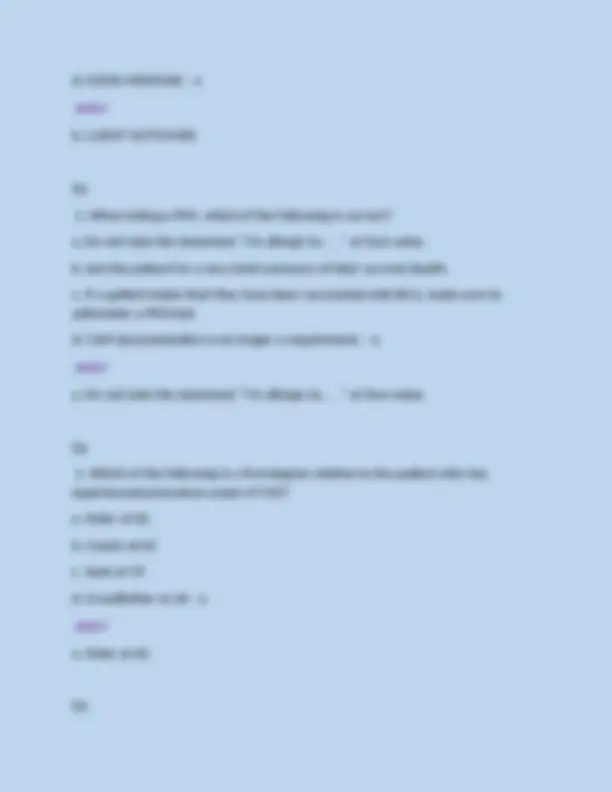






























































































Study with the several resources on Docsity

Earn points by helping other students or get them with a premium plan


Prepare for your exams
Study with the several resources on Docsity

Earn points to download
Earn points by helping other students or get them with a premium plan
Community
Ask the community for help and clear up your study doubts
Discover the best universities in your country according to Docsity users
Free resources
Download our free guides on studying techniques, anxiety management strategies, and thesis advice from Docsity tutors
NUR 504 - Final Exam questions and answers rated a plus
Typology: Exams
1 / 108

This page cannot be seen from the preview
Don't miss anything!





























































































Qs Which of the following is an example of subjective data that may be collected during a health assessment? a. Height and weight b. A patient's recall of his or her past health conditions c. Results from an abdominal CT scan d. Complete blood count - n ANS✔ b. A patient's recall of his or her past health conditions Qs
d. GOOD MEDICINE - n ANS✔ b. CLIENT OUTCOMES Qs
Qs
c. Patient interaction and scope Qs
d. Observing posture and balance - n ANS✔ c. Testing hearing Qs
Indirect percussion involves touch by instrument or object and requires no physical contact between the physician and patient. - n ANS✔ False Qs The physical exam begins as the patient enters the room. - n ANS✔ True Qs Jugular venous pressure is measured when the patient is reclining 45 degrees. - n ANS✔ True Qs The kidneys should be examined both while the patient is supine and while the patient is seated facing away from the examiner. - n ANS✔ True Qs Which of the following is true of healthcare institutions regarding documentation?
a. To comply with HIPAA regulations, institutions must ensure that computer monitors with sensitive patient data are not left unattended. b. All institutions must follow a standard policy for posting abbreviations in documentation drawn from the AMA. c. Institutions consider drawings a fairly inaccurate way to represent a patient's systems or picture of the patient's condition. d. As of 2003, faxes may no longer be used to share patient medical information between institutions - n ANS✔ a. To comply with HIPAA regulations, institutions must ensure that computer monitors with sensitive patient data are not left unattended. Qs SOAP stands for: a. standard operating and admitting procedures. b. sanitation, observation, auscultation, palpation. c. surgeons, officials, administrators, patients. d. subjective, objective, assessment, plan, - n ANS✔ d. subjective, objective, assessment, plan, Qs Which of the following is recorded in documentation as direct patient quotes? a. The chief complaint and follow-up responses b. The chief complaint only c. Nothing; everything is written in precise medical terminology
a. If a patient describes having pain in the arm and numbness in the fingertips, the physician should examine these as a single unit. Qs Which is the preferred order of taking down a patient's subjective information? a. Family history, physical exam, diagnostic tests, assessment b. SOAP c. HPI, past medical history, family history, social history d. HPI, family history, physical exam, assessment - n ANS✔ c. HPI, past medical history, family history, social history Qs What is a genogram? a. A genetic test performed in a doctor's office b. A visual representation or chart of a patient's family history c. A biometric monitor worn during a physical exam d. A computer report correlating information from the patient's history, exam, and diagnostic tests - n ANS✔ b. A visual representation or chart of a patient's family history Qs
In a physical examination, the physician spends the most attention on the patient's musculoskeletal and neurological systems. What can we deduce from this? a. The same systems were likely not explored in the review of systems. b. This is a comprehensive examination. c. Documentation from the subjective component of the patient's visit has pointed the physician to these systems. The diagnosis will be firmly established after assessment of both systems. - n ANS✔ c. Documentation from the subjective component of the patient's visit has pointed the physician to these systems. Qs
c. Nonpharmacological interventions Qs Documentation that just indicates that the healthcare provider found "no problems" is unacceptable because of lack of precision and clarity of what was asked and what was assessed - n ANS✔ True Qs HIPAA regulations permit healthcare institutions to share a patient's information without their consent, but only to other accredited healthcare institutions and only if strict security measures are in place. - n ANS✔ False Qs The format and extent of information gathered are different for each subclassification of the SOAP approach - n ANS✔ False Qs If the patient reports that 5 years ago she had a "heart attack," it is important for the physician to note this using the patient's own terminology. - n ANS✔
False Qs "Patient holds an M.A. in art history and curates a small museum; occupation calls for standing 6-7 hours a day" is an example of documentation of a patient's social history - n ANS✔ True Qs The assessment plan for all patients will contain new diagnoses, differential diagnoses, and a problem list. - n ANS✔ False Qs The internal os is contained within what? a. The uterus b. The vagina c. The ovaries d. The clitoris - n ANS✔ a. The uterus Qs